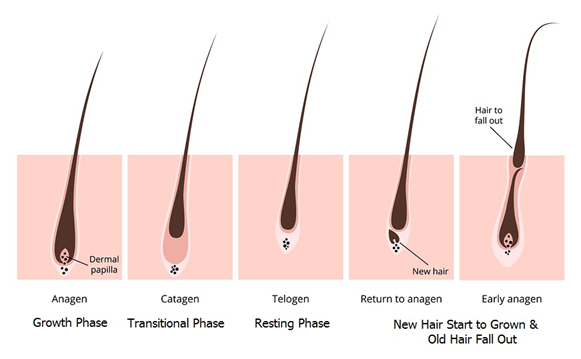Understanding Natural Hair Growth Cycle
It is important to understand how the hair grows to understand problems you may encounter with your hair, such as hair loss.

People are born with about 100,000 hair follicles on their head and this numbers varies among different ages and hair colors. Blondes have an average of 150,000 follicles, brown or black hair has 110,000 hair follicles, while redheads have around 90,000 follicles.
The adult body has approximately 5,000,000 hair follicles, with men having a few hundred thousand more than women.
Hair strands grow out from hair follicles in the skin. At the base of the hair follicle is the hair bulb. In the hair bulb, hair papilla divides and grows into a new strand of hair. The blood vessels provide nourishment for the hair to grow.
So, what is the natural hair growth cycle?

There are four phases of the hair growth cycle and they are: Anagen (growth phase), Catagen (Transitional phase), Telogen (Resting Phase) and Exogen (Shedding phase).
Anagen Phase
The Anagen phase is the phase where hair grows. Normally the Anagen phase lasts from between 2-7 years to grow hair up to 30 inches. This phase can last longer for Asians who can grow 1 meter long hair in 7 years. At any given time, approximately 85%-90% of hair on your head is in the Anagen phase.
Catagen Phase
After the Anagen phase ends, your hair enters the Catagen phase which lasts for 10 days. Hair growth slows and hair follicles start to shrink. About 3% of all your hair is during this phase at any given time.
Telogen Phase
Then your hair enters the Telogen phase, during which the hair follicle is completely at rest and no longer growing. This phase lasts a few months. Between 6% – 8% of your hair is in this phase at any given time.
Exogen Phase
Then your hair starts to fall out. This is why you see hair shedding during the shower every day.
After the four phases, the follicles then remain inactive for 3 months and then the whole process is repeated. Each hair follicle is independent from each other and each is in a different phase at any given time.
So if the growth cycle is disrupted, then you will have hair loss problems. Many factors can interrupt the process including diseases, metabolic imbalances, age, genetics, stress or hormonal changes and more.